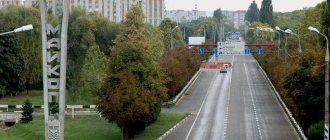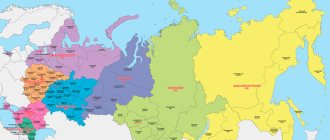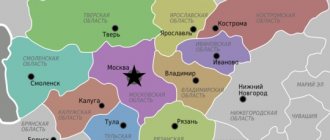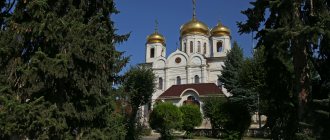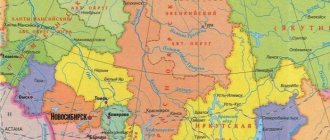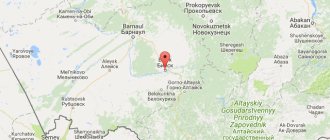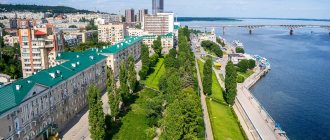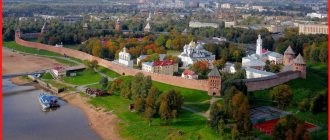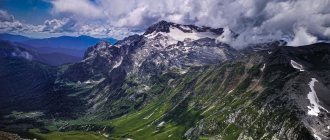The Khabarovsk Territory is known on the map of Russia as one of the most unique, due to the extraordinary richness of its nature, the abundance of lakes, rivers, and various relief forms. Its cities and towns are inhabited mainly by indigenous small-numbered northern peoples - Evenks, Udeges, Ulchis, Nanais, Nivkhs, Orochs, Negidals and Evens.
The region is located in the center of the Russian Far East and is one of the largest administrative-territorial entities of the Russian Federation. The Khabarovsk Territory, the cities and other settlements of which are shown on the map, borders China along the Kazakevich Channel and the Ussuri River. The closest neighbors on the territory of the Russian Federation are: the Jewish Autonomous Region, Primorsky Krai, Yakutia, Amur and Magadan regions. From the east, the region is washed by the seas of Japan and Okhotsk. It is separated from Sakhalin Island by the Nevelsk and Tatar straits. The length of the coastline of the Khabarovsk Territory is about 2.5 thousand km. In addition to the continental part, it contains several islands, the largest of which are the Shantar Islands.
What holiday is it today?
February 10, 2022, Thursday
Today are holidays, events: Diplomat's Day Tomorrow: World Sick Day Discovery of insulin
Today is the Orthodox holiday: St. Ephraim the Syrian. Venerable Ephraim of Novotorzhsky. Venerable Ephraim of Pechersk, Bishop of Pereyaslavl. Venerable Theodosius of Totem, Spasosumorin of the monastery, leader and founder... Tomorrow: Transfer of the relics of the holy martyr Ignatius the God-Bearer. Saints Gerasim, Pitirim, Jonah, bishops of Great Perm, Ustva...
Today is a national holiday: Ephraim's Day... Tomorrow: Lawrence's Day
Seasons
Seasons, four periods of the year (spring, summer, autumn and winter) characterized by certain average temperatures. The period during which the Sun passes through one of these sectors is called the season. Spring in the Northern Hemisphere and autumn in the Southern Hemisphere begin when the Sun passes through the initial circle of declination and its right ascension is 0° (vernal equinox). Summer in the Northern Hemisphere and winter in the Southern Hemisphere occur when the sun's right ascension is 90° (summer solstice). Autumn in the Northern Hemisphere and spring in the Southern Hemisphere begin when the sun's right ascension is 180° (autumnal equinox). The beginning of winter in the Northern Hemisphere and summer in the Southern Hemisphere is considered to be the winter solstice, when the direct ascension of the Sun is 270°... Next: Seasons. Russian folk calendar. Monthly words...
see also
- Khabarovsk region
- Cities of Russia
| [ + ] Cities by regions of Russia | |
| Cities of the North-West (NWFD) | St. Petersburg (and its cities) • Leningrad region (historical Staraya Ladoga) • Arkhangelsk region • Vologda region • Kaliningrad region • Karelia • Komi • Murmansk region • Nenets Autonomous Okrug • Pskov region |
| Cities of the Volga region (Volga Federal District) | Bashkortostan • Volgograd region • Kalmykia • Kirov region • Mari El • Mordovia • Nizhny Novgorod region • Orenburg region • Penza region • Perm region • Samara region • Saratov region • Tatarstan • Udmurtia • Ulyanovsk region • Chuvashia |
| Cities of Southern Russia (SFD) | Sevastopol (including Inkerman) • Republic of Crimea • Adygea • Astrakhan region • Krasnodar region • Rostov region |
| Cities of the North Caucasus (NCFD) | Dagestan • Ingushetia • Kabardino-Balkaria • Karachay-Cherkessia • North Ossetia - Alania • Stavropol Territory • Chechen Republic |
| Cities of the Urals (Ural Federal District) | Kurgan region • Sverdlovsk region • Tyumen region • Khanty-Mansi Autonomous Okrug - Yugra • Chelyabinsk region • Yamalo-Nenets Autonomous Okrug |
| Cities of Siberia (Siberian Federal District) | Altai Republic • Altai Territory • Irkutsk Region • Kemerovo Region • Krasnoyarsk Region • Novgorod Region • Novosibirsk Region • Omsk Region • Tomsk Region • Tyva • Khakassia |
| Cities of the Far East (FEFD) | Amur Region • Buryatia • Jewish Autonomous Region • Trans-Baikal Territory • Kamchatka Territory • Magadan Region • Primorsky Territory • Sakha (Yakutia) • Sakhalin Region • Khabarovsk Territory • Chukotka Autonomous Region |
| see also | Cities of the DPR, LPR, Transnistria, South Ossetia • Regions of Russia • Cities of Russia |
Folk calendar about every day
Every day one season always replaces another and this determines a person’s way of life. In connection with this, a folk calendar was formed in which there were practically no nameless, unmarked days. Every day was special, had its own purpose. All this was determined by climate conditions and astrological phenomena.
A calendar is a system for counting periods of time. The first calendars arose a long time ago, in ancient times, because there was a need to measure time. The word calendar comes from the Latin words caleo - to proclaim and calendarium - debt book. This is due to the fact that in Ancient Rome the beginning of each month was especially proclaimed, and because it was customary to pay debts on the first day of the month. Different peoples counted time differently. Some calendars are based on the changing phases of the moon - lunar calendars; in others - the change of seasons - sunny; in others, the length of the year was coordinated with the change of seasons, and the counting of months was associated with the phases of the Moon. Such calendars are called lunisolar.
In Rus', the calendar was called a monthly calendar. Every day, the month book covered the entire year of peasant life, “describing” day by day, month after month, where each day had its own holidays or weekdays, customs and superstitions, traditions and rituals, natural signs and phenomena. The cyclical nature of the calendar is reminiscent of human life, where spring is youth, summer is heyday, autumn is the time of harvesting fruits (it’s good if there are some, otherwise you can live your life without collecting fruits), winter is the time of wisdom and peace. This cyclicality and rhythm determined the way of life of the farmer. The folk calendar was an agricultural calendar, which was reflected in the names of the months, folk signs, rituals and customs. Even the determination of the timing and duration of the seasons is associated with real climatic conditions. Hence the discrepancy between the names of the months in different areas... Next: Folk calendar...
Natural conditions
The territory of the region is located in the monsoon climate zone. However, only a third of it is influenced by warm air masses coming from the tropical and subtropical parts of the Pacific Ocean. This is the area from the southern border with Primorye and China to the Bureinsky ridge and the river. Amgun.
The entire remaining territory of the region is located in a zone with harsh climatic conditions, where the development of agriculture is extremely difficult.
The satellite map gives a comprehensive picture of the natural features of the region. From the point of view of relief, the Khabarovsk Territory can be divided into two unequal parts. This is a plain located between the Amur and Amgun rivers.
The rest of the territory of the region is covered with mountains with predominant heights from 500 to 2000 m above sea level. Main ridges:
- Bureinsky:
- Sikhote-Alin;
- Dgugdzhursky;
- Yam-Alin;
- Dusse-Alin.
Vegetation is represented in the south by relict cedar-broad-leaved forests. The rest of the region is occupied by taiga and tundra.
Fishing calendar for every day
The fishing calendar should not be taken as an absolutely indisputable truth. Fish biting is greatly influenced by a whole range of natural factors, as well as the influence on the nature of man himself. You must not forget that the fish’s bite depends and is determined not only by the calendar dates and biological cycles of their life, reflected in the calendar, but also, no less, by the state of their habitat; the bite also depends on weather conditions: air and water temperatures, cloudiness, wind direction and strength, etc... Next: Fishing calendar...
Districts[ | ]
Amur[ | ]
| List of settlements | |||
| № | Locality | Type | Population |
| 1e-06 | City of regional significance | ||
| 1 | Amursk | city | 38 694 |
| 1.000002 | Settlement | ||
| 2 | Elban | workers' village | 10 724 |
| 2.000003 | Rural settlements | ||
| 3 | Achan | village | 512 |
| 4 | Bologne | village | 946 |
| 5 | Vandan | village station | 10 |
| 6 | Voznesenskoye | village | 2061 |
| 7 | Golubichnoye | village | 22 |
| 8 | Jarman | village station | 6 |
| 9 | Jelyumken | village station | 14 |
| 10 | Juyeon | village | 461 |
| 11 | Dippas | village | 36 |
| 12 | Lime | village | 1574 |
| 13 | Forest | village | 335 |
| 14 | Litovko | village | 2043 |
| 15 | Malmyzh | village station | 98 |
| 16 | Mengon | village station | 36 |
| 17 | Nushi | village station | 9 |
| 18 | Ommie | village | 413 |
| 19 | Carrion | village | 389 |
| 20 | Partisan Hills | village station | 5 |
| 21 | Fish base | village | 50 |
| 22 | Sunboli | village | 1109 |
| 23 | Selgon | village station | 82 |
| 24 | Teishin | village station | 42 |
| 25 | Ukrainian | village | 105 |
| 26 | Ust-Gur | village | 122 |
| 27 | Trout | village station | 144 |
| 28 | Khevcen | traveling | 30 |
| 29 | traveling | 33 | |
| 30 | traveling | 21 | |
| 31 | 37 km | barracks | 2 |
| 32 | 147 km | village station | 9 |
| 33 | 207 km | barracks | 15 |
| 34 | 213 km | barracks | 0 |
| 35 | 286 km | barracks | 1 |
Ayano-Maisky[ | ]
| List of settlements | |||
| № | Locality | Type | Population |
| 1 | Aim | village | 205 |
| 2 | Aldoma | assembly station | 0 |
| 3 | Ayan | village | 967 |
| 4 | Batomga | weather station | 4 |
| 5 | Jigda | village | 264 |
| 6 | Kurun-Uryakh | weather station | 5 |
| 7 | Nelkan | village | 843 |
| 8 | Split | assembly station | 4 |
| 9 | Semirechye | assembly station | 0 |
| 10 | Fedorovo | village | 0 |
| 11 | Tsipanda | assembly station | 0 |
Bikinsky[ | ]
| List of settlements | |||
| № | Locality | Type | Population |
| 1e-06 | City of regional significance | ||
| 1 | Bikin | city | 16 026 |
| 1.000002 | Rural settlements | ||
| 2 | Boytsovo | village | 54 |
| 3 | Vasilyevka | village | 33 |
| 4 | Dobrolyubovo | village | 126 |
| 5 | Lermontovka | village | 3945 |
| 6 | Sawmill | village | 893 |
| 7 | Lonchakovo | village | 534 |
| 8 | Orenburgskoe | village | 754 |
| 9 | Copse | village | 26 |
| 10 | Pokrovka | village | 224 |
| 11 | Pushkino | village | 472 |
| 12 | Rozengartovka | village | 203 |
Vaninsky[ | ]
| List of settlements | |||
| № | Locality | Type | Population |
| 1 | Akur | village station | 26 |
| 2 | Akur State Farm | village | 2 |
| 3 | Vanino | workers' village | 14 986 |
| 4 | Alpine | workers' village | 3376 |
| 5 | Datta | village station | 19 |
| 6 | Datta | village | 652 |
| 7 | Duanka | village | 7 |
| 8 | Kenada | village | 775 |
| 9 | Cosgrambo | village station | 7 |
| 10 | Koto | village station | 30 |
| 11 | Kuznetsovsky | village station | 4 |
| 12 | Mongokhto | village | 4120 |
| 13 | October | workers' village | 5514 |
| 14 | Oune | village station | 16 |
| 15 | Currents | village | 2505 |
| 16 | Tuluchi | village | 698 |
| 17 | Tumnin | village | 1000 |
| 18 | Uska-Orochskaya | village | 813 |
| 19 | Uska-Russian | village | 0 |
| 20 | Hutu | village | 14 |
Verkhnebureinsky [ | ]
| List of settlements | |||
| № | Locality | Type | Population |
| 1 | Adnikan | traveling | 0 |
| 2 | Alanap | village | 227 |
| 3 | Alonka | village | 431 |
| 4 | Funny | village | 54 |
| 5 | Herbie | village | 320 |
| 6 | Zimovye | village station | 77 |
| 7 | Foliar | village | 0 |
| 8 | Midge | village station | 0 |
| 9 | New Urgal | workers' village | 6151 |
| 10 | Sogd | village | 135 |
| 11 | Soloni | village | 227 |
| 12 | Sofiysk | village | 435 |
| 13 | Middle Urgal | village | 467 |
| 14 | Construction site | village | 1 |
| 15 | Suluk | village | 699 |
| 16 | Talanja | village station | 84 |
| 17 | Tarakelok | village station | 4 |
| 18 | Tyrma | village | 1933 |
| 19 | Urgal | village | 71 |
| 20 | Ust-Urgal | village | 202 |
| 21 | Ushman | village station | 86 |
| 22 | CES | village | 983 |
| 23 | Chegdomyn | workers' village | 11 450 |
| 24 | Chekunda | village | 200 |
| 25 | Shakhtinsky | village | 74 |
| 26 | Elga | village station | 153 |
| 27 | Etyrken | village | 665 |
| 28 | Ehilkan | village station | 72 |
| 29 | Yagdynya | village station | 0 |
| 30 | 142 km | barracks | 1 |
Vyazemsky[ | ]
| List of settlements | |||
| № | Locality | Type | Population |
| 1 | Avan | village | 760 |
| 2 | Venyukovo | village | 353 |
| 3 | Vidnoe | village | 132 |
| 4 | Vinogradovka | village | 198 |
| 5 | Vyazemsky | city | 12 969 |
| 6 | Goedicke | village station | 13 |
| 7 | Glebovo | village | 258 |
| 8 | Dormidontovka | village | 1426 |
| 9 | Dormidontovka | village | 556 |
| 10 | Zabaikalskoe | village | 415 |
| 11 | Kamenushka | village station | 13 |
| 12 | Kapitonovka | village | 488 |
| 13 | Kedrovo | village | 111 |
| 14 | Kotikovo | village station | 51 |
| 15 | Kotikovo | village | 564 |
| 16 | Krasitskoe | village | 678 |
| 17 | Kukelevo | village | 219 |
| 18 | Bearish | village | 136 |
| 19 | Otradnoe | village | 860 |
| 20 | Luxury | village | 1 |
| 21 | Sadovoye | village | 212 |
| 22 | Snarsky | village | 15 |
| 23 | Sheremetyevo | village | 621 |
| 24 | Noisy | village | 339 |
Name Lazo[ | ]
| List of settlements | |||
| № | Locality | Type | Population |
| 1 | 34 kilometer | village | 66 |
| 2 | 43 kilometer | village | 214 |
| 3 | 52 kilometer | village | 33 |
| 4 | Argunskoe | village | 4 |
| 5 | Bustard Base | village | 553 |
| 6 | Bichevaya | village | 1509 |
| 7 | Vasilyevka | village | 98 |
| 8 | Vladimirovka | village | 144 |
| 9 | Second Slavnoy Section | village | 82 |
| 10 | Gwasyugi | village | 251 |
| 11 | Georgievka | village | 1431 |
| 12 | Grodekovo | village | 1152 |
| 13 | Far Eastern | village | |
| 14 | Dolmi | village | 351 |
| 15 | Bustard | village | 615 |
| 16 | Durmin | village | 847 |
| 17 | Ekaterinoslavka | village | 856 |
| 18 | Snake | village | 12 |
| 19 | Zoevka | village | 180 |
| 20 | Gold | village | 427 |
| 21 | Kamenets-Podolsk | village | 65 |
| 22 | Katen | village | 108 |
| 23 | Kiinsk | village | 580 |
| 24 | Kiya | village | 170 |
| 25 | Kondratyevka | village | 350 |
| 26 | Kruglikovo | village station | 76 |
| 27 | Kruglikovo | village | 299 |
| 28 | Kutuzovka | village | 101 |
| 29 | Marusino | village | 487 |
| 30 | Mogilevka | village | 1276 |
| 31 | Muchen | workers' village | 3419 |
| 32 | Nevelskoye | village | 79 |
| 33 | New building | village | 710 |
| 34 | Obor | village | 666 |
| 35 | Pavlenkovo | village | 443 |
| 36 | Pereyaslavka | workers' village | 7398 |
| 37 | Petrovichi | village | 285 |
| 38 | Flight | village | 1156 |
| 39 | Prudki | village | 128 |
| 40 | Svyatogorye | village | 769 |
| 41 | Sidima | village | 767 |
| 42 | Sita | village | 1883 |
| 43 | Sokolovka | village | 375 |
| 44 | Solontsovy | village | 337 |
| 45 | Srednekhorsky | village | 234 |
| 46 | Sukpai | village | 1191 |
| 47 | Third Rafting Section | village | 63 |
| 48 | Haka | village | 171 |
| 49 | Choir | workers' village | 8827 |
| 50 | Chernyaevo | village | 1068 |
| 51 | Shapovalovka | village | 12 |
| 52 | Southern | village | 176 |
Named after Polina Osipenko[ | ]
| List of settlements | |||
| № | Locality | Type | Population |
| 1 | Briakan | village | 1173 |
| 2 | Vesyolaya Gorka | village | 77 |
| 3 | Vladimirovka | village | 251 |
| 4 | Main Stan | village | 146 |
| 5 | Guga | village | 1 |
| 6 | named after Polina Osipenko | village | 2252 |
| 7 | Kamenka | hydrological post | 1 |
| 8 | Knyazevo | village | 42 |
| 9 | Neelankan | communication control point | 0 |
| 10 | Good | hydrological post | 1 |
| 11 | Oglongs | village | 530 |
| 12 | October | village | 0 |
| 13 | Timchenko | hydrological post | 2 |
| 14 | Udinsk | village | 92 |
| 15 | Upagda | hydrological post | 2 |
| 16 | Herpuchi | village | 628 |
Komsomolsky[ | ]
| List of settlements | |||
| № | Locality | Type | Population |
| 1 | Belgo | village | 378 |
| 2 | Beachy | village | 4 |
| 3 | Boctor | village | 343 |
| 4 | Big Cartel | village | 1568 |
| 5 | Verkhnetambovskoe | village | 173 |
| 6 | Verkhnyaya Ekon | village | 531 |
| 7 | Gaither | village station | 37 |
| 8 | Gaither | village | 2212 |
| 9 | Galichny | village | 581 |
| 10 | Gurskoe | village | 777 |
| 11 | Dapps | village | 358 |
| 12 | Holiday home Shargol | recreation center | 1 |
| 13 | Kenai | village | 588 |
| 14 | Mast | village | 3 |
| 15 | Youth | village | 1422 |
| 16 | Nizhnetambovskoe | village | 942 |
| 17 | Lower Halby | village | 351 |
| 18 | Novoilinovka | village | 86 |
| 19 | New world | village | 1114 |
| 20 | October | village | 2 |
| 21 | Pivan | village | 1754 |
| 22 | Pioneer camp named after Oleg Koshevoy | village | 6 |
| 23 | Pony | village station | 4 |
| 24 | Pochepta | village station | 2 |
| 25 | Selikhino | village | 4255 |
| 26 | Snow | village | 1902 |
| 27 | Srednetambovskoe | village | 29 |
| 28 | Uktur | village | 1714 |
| 29 | Khurba | village | 5957 |
| 30 | Black Cape | village | 198 |
| 31 | Shelekhovo | village | 30 |
| 32 | Eldigan | village station | 9 |
| 33 | Emmer | village | 5 |
| 34 | Berry | village | 1719 |
| 35 | 105 km | traveling | 12 |
Nanaisky[ | ]
| List of settlements | |||
| № | Locality | Type | Population |
| 1 | Arsenyevo | village | 334 |
| 2 | Upper Nergen | village | 508 |
| 3 | Upper Manoma | village | 201 |
| 4 | Gussie | village | 48 |
| 5 | Yes Yes | village | 433 |
| 6 | Daerga | village | 801 |
| 7 | Jari | village | 687 |
| 8 | Junk | village | 1310 |
| 9 | Oak Cape | village | 1358 |
| 10 | Innokentyevka | village | 1109 |
| 11 | Spark | village | 35 |
| 12 | Lidoga | village | 1634 |
| 13 | Malmyzh | village | 72 |
| 14 | Lighthouse | village | 1638 |
| 15 | Naikhin | village | 945 |
| 16 | Lower Manoma | village | 181 |
| 17 | Sinda | village | 868 |
| 18 | Slav | village | 98 |
| 19 | Trinity | village | 5143 |
| 20 | Uni | village | 88 |
Nikolaevsky[ | ]
| List of settlements | |||
| № | Locality | Type | Population |
| 1e-06 | City of regional significance | ||
| 1 | Nikolaevsk-on-Amur | city | 17 668 |
| 1.000002 | Urban settlements | ||
| 2 | Lazarev | workers' village | 925 |
| 3 | Multivertex | workers' village | 1891 |
| 3.000003 | Rural settlements | ||
| 4 | Aleevka | village | 60 |
| 5 | Alekseevka | village | 7 |
| 6 | Baidukovo | village | 5 |
| 7 | Vidanovo | village | 39 |
| 8 | Vlasyevo | village | 18 |
| 9 | Gyrman | village | 68 |
| 10 | Jaore | village | 3 |
| 11 | Innokentyevka | village | 464 |
| 12 | Konstantinovka | village | 594 |
| 13 | Red | village | 980 |
| 14 | Litke | village | 8 |
| 15 | Mago | village | 1480 |
| 16 | Makarovka | village | 7 |
| 17 | Nigir | village | 443 |
| 18 | Lower Pronge | village | 307 |
| 19 | Ozerpakh | village | 235 |
| 20 | Orel-Chlya | village | 43 |
| 21 | Oremith | village | 262 |
| 22 | Podgornoye | village | 16 |
| 23 | Puir | village | 223 |
| 24 | Sakharovka | village | 60 |
| 25 | Free | village | 0 |
| 26 | Tneyvakh | village | 24 |
| 27 | Chlya | village | 630 |
| 28 | Chnyrrakh | village | 334 |
Okhotsky[ | ]
| List of settlements | |||
| № | Locality | Type | Population |
| 1 | Arch | village | 699 |
| 2 | Airport | village | 427 |
| 3 | Bulgin | village | 650 |
| 4 | Vostretsovo | village | 560 |
| 5 | Inya | village | 370 |
| 6 | Nautical | village | 180 |
| 7 | New Inya | village | 422 |
| 8 | Novoe Ustye | village | 351 |
| 9 | Nyadbaki | village | 49 |
| 10 | Okhotsk | workers' village | 3144 |
| 11 | Residence | village | 121 |
| 12 | Agricultural farm | village | 28 |
| 13 | Uschan | village | 58 |
Soviet-Havansky[ | ]
| List of settlements | |||
| № | Locality | Type | Population |
| 1e-06 | City of regional significance | ||
| 1 | Sovetskaya Gavan | city | 23 245 |
| 1.000002 | Urban settlements | ||
| 2 | Testaments of Ilyich | workers' village | 8410 |
| 3 | Salmon | workers' village | 2941 |
| 4 | May | workers' village | 2215 |
| 4.000003 | Rural settlements | ||
| 5 | Gatka | village | 777 |
| 6 | Grossevichi | village | 3 |
| 7 | Innokentyevsky | village | 5 |
| 8 | Coppy | village | 17 |
| 9 | Nelma | village | 8 |
Sunny[ | ]
| List of settlements | |||
| № | Locality | Type | Population |
| 1 | Amgun | village | 461 |
| 2 | Birch | village | 5498 |
| 3 | Is ill | village | 132 |
| 4 | Gorin | village | 4152 |
| 5 | Mountain | village | 1523 |
| 6 | Jamku | village | 646 |
| 7 | House-building Factory | village | 503 |
| 8 | Dookie | weather station | 0 |
| 9 | Dookie | village | 1727 |
| 10 | Condon | village | 482 |
| 11 | Lian | village | 603 |
| 12 | Mavrinsk | village | 2 |
| 13 | Agricultural | village | 80 |
| 14 | Solar | workers' village | 11 712 |
| 15 | Tavlinka | village | 216 |
| 16 | Halgaso | village | 223 |
| 17 | Harpichan | village | 848 |
| 18 | Khurmuli | village | 1950 |
| 19 | Evoron | village | 1344 |
Tuguro-Chumikansky[ | ]
| List of settlements | |||
| № | Locality | Type | Population |
| 1 | Algazeya | village | 63 |
| 2 | Big Shantar | weather station | 4 |
| 3 | Burukan | weather station | 5 |
| 4 | Jana | weather station | 5 |
| 5 | Neran | village | 90 |
| 6 | Thor | village | 127 |
| 7 | Tugur | village | 389 |
| 8 | Udskoye | village | 418 |
| 9 | Chumikan | village | 1154 |
Ulchsky[ | ]
| List of settlements | |||
| № | Locality | Type | Population |
| 1 | Anninskie Mineral Waters | village | 234 |
| 2 | Beloglinka | village | 51 |
| 3 | Bogorodskoye | village | 3900 |
| 4 | Big Sanniki | village | 392 |
| 5 | Mace | village | 1720 |
| 6 | Bystrinsk | village | 252 |
| 7 | Voskresenskoye | village | 23 |
| 8 | De-Kastri | village | 3238 |
| 9 | Doody | village | 340 |
| 10 | Village named after Maxim Gorky | village | 4 |
| 11 | Kalinovka | village | 195 |
| 12 | Kalma | village | 84 |
| 13 | Kesey | village | 16 |
| 14 | Kiselyovka | village | 789 |
| 15 | Key | village | 106 |
| 16 | We ring | village | 65 |
| 17 | Mariinsky Raid | village | 608 |
| 18 | Mariinsky | village | 656 |
| 19 | Mongol | village | 102 |
| 20 | Lower Harbor | village | 225 |
| 21 | Novotroitskoe | village | 6 |
| 22 | Decisive | village | 245 |
| 23 | Savinskoye | village | 327 |
| 24 | Solontsy | village | 463 |
| 25 | Sofiysk | village | 895 |
| 26 | Susanino | village | 845 |
| 27 | Ottoman | village | 660 |
| 28 | Tulinskoe | village | 0 |
| 29 | Tyr | village | 590 |
| 30 | Ukhta | village | 156 |
| 31 | Zimmermanovka | village | 1504 |
| 32 | Chilba | village | 38 |
Khabarovsk[ | ]
| List of settlements | |||
| № | Locality | Type | Population |
| 1 | Anastasevka | village | 2154 |
| 2 | Blagodatnoe | village | 820 |
| 3 | Bychikha | village | 1603 |
| 4 | Vinogradovka | village | 819 |
| 5 | Voronezhskoe-1 | village | 11 |
| 6 | Voronezhskoe-2 | village | 182 |
| 7 | Voronezhskoe-3 | village | 29 |
| 8 | Eastern | village | 3700 |
| 9 | Sunrise | village | 228 |
| 10 | Vyatskoe | village | 1886 |
| 11 | Galkino | village | 1599 |
| 12 | Garovka-1 | village | 1302 |
| 13 | Garovka-2 | village | 1795 |
| 14 | Dogordon | village | 81 |
| 15 | Friendship | village | 1946 |
| 16 | Elabuga | village | 677 |
| 17 | Zaozernoye | village | 3931 |
| 18 | Ivankovtsy | village | 5 |
| 19 | Ilyinka | village | 2729 |
| 20 | Kazakevichevo | village | 824 |
| 21 | Kalinka | village | 2216 |
| 22 | Prince-Volkonsky | village | 9155 |
| 23 | Konstantinovka | village | 382 |
| 24 | Korsakovo-1 | village | 874 |
| 25 | Korsakovo-2 | village | 66 |
| 26 | Korfovsky | workers' village | 5848 |
| 27 | Krasnoznamenka | village | 45 |
| 28 | Krasnorechenskoe | village | 2165 |
| 29 | Krasnoselskoe | village | 7 |
| 30 | Kukan | village | 980 |
| 31 | Lesnoye | village | 149 |
| 32 | Robin | village | 145 |
| 33 | Malyshevo | village | 871 |
| 34 | Matveevka | village | 2974 |
| 35 | Peaceful | village | 1574 |
| 36 | Michurinskoe | village | 987 |
| 37 | Nagornoye | village | 257 |
| 38 | Naumovka | village | 75 |
| 39 | Nekrasovka | village | 8883 |
| 40 | Novokamenka | village | 2 |
| 41 | Novokurovka | village | 460 |
| 42 | Novotroitskoe | village | 216 |
| 43 | Aspen River | village | 1751 |
| 44 | Apiary | village | 392 |
| 45 | Petropavlovka | village | 125 |
| 46 | Victory | village | 733 |
| 47 | Rakitnoye | village | 2348 |
| 48 | Rivne | village | 86 |
| 49 | Roschino | village | 746 |
| 50 | Svechino | village | 43 |
| 51 | Sergeevka | village | 1829 |
| 52 | Sikachi-Alyan | village | 264 |
| 53 | Skvortsovo | village | 158 |
| 54 | Smirnovka | village | 142 |
| 55 | Sosnovka | village | 1795 |
| 56 | Taiga | village | 3362 |
| 57 | Tomskoe | village | 4 |
| 58 | Topolevo | village | 4384 |
| 59 | Ulika-National | village | 155 |
| 60 | Ulika-Pavlovka | village | 1 |
| 61 | Fedorovka | village | 516 |
| 62 | Hail | village | 1 |
| 63 | Khekhtsir | village | 89 |
| 64 | Chelny | village | 97 |
| 65 | Black River | village | 1382 |
| 66 | Black Forest | village | 6 |
| 67 | Teal | village | 105 |
| 68 | Chistopolye | village | 262 |
| 69 | 18 km | village | 13 |
| 70 | 24 km | village | 78 |
Orthodox calendar about every day
Orthodox calendar: Orthodox, Church and Christian holidays.
The church year is an alternation of weekdays and holidays. On weekdays, a person is called to work “by the sweat of his brow to earn his bread.” Holidays are given in order to feel liberation, to rise above the bustle and routine of the world, to feel involved in the highest of worlds, “where there are no illnesses, sorrows and sighs, but endless life.” Since ancient times, holiday cycles have been associated with the seasons. The pagans associated them with the worship of the forces of nature, the cult of which in the Old Testament was replaced by gratitude to the Creator for the universe. And although the connection between holidays and the seasons has not completely lost its power, since God is present in everything, in the plant and animal world, in human works, it nevertheless faded into the background, giving way to a spiritual foundation built on the Sacred Scriptures. The history of Orthodox holidays dates back to the times of the Old Testament. Each of the Orthodox holidays is dedicated to the remembrance of the most important events in the life of Jesus Christ and the Mother of God, as well as the memory of saints... Next: Orthodox calendar...
Khabarovsk Territory: cities
- Khabarovsk. It is the administrative center and largest city of the region, one of the regional centers. Population: 577.7 thousand people.
- Komsomolsk-on-Amur. It is a large industrial center. Number of inhabitants: 257,751 people.
- Amursk A satellite city of Komsomolsk-on-Amur, the administrative center of the Amur region. Population: 43,420 people.
- Nikolaevsk-on-Amur. A small port city on the river. Lower Amur. Number of inhabitants: 22,634 people.
- Sovetskaya Gavan. Another port town, a regional center. Population: 27,671 people.
- Vyazemsky. A small town located in the south of the region. This is one of the major railway stations.
- Bikin. The southernmost city, located on the border with the Primorsky Territory, regional center. 17,156 people live here.
Russian folk calendar for every day
The word “sign” comes from the word “notice”, i.e. observe. As a result of observing what happens around a person every day, he accumulates life experience. This knowledge was passed down from generation to generation, carefully preserved and people trusted it as a sacred book. Many signs have come to us from the depths of centuries without losing their knowledge. Each of us is free to choose: to dismiss all this as an absurd superstition or to take a closer look at the signs and take the centuries-old experience of generations more seriously. Most of us, when taking exams, ask them to scold them, boasting about some kind of good fortune or luck, spit so as not to jinx them or knock on wood, take a detour if a black cat crossed the road, are afraid of the number 13 and much more. And who among us does not have lucky things, numbers? Who has never resorted to the help of fate at least once in their life, who has not believed in secrets? It’s as if everything connected with signs is hidden somewhere deep in our subconscious. Often we remember them mechanically, unconsciously, or just as a joke. But, undoubtedly, the signs contain a lot of accurate knowledge and practical wisdom of our ancestors. They cover all the characteristic, often difficult to perceive, natural phenomena. Signs have preserved a lot of what was in old folk holidays and customs; they help predict the weather, grow crops... Next: Folk signs...
Composition by gender and age
The population of the Khabarovsk Territory is represented mainly by young people aged 25 to 29 years. There are more than 120 thousand of them. There are not many old people in the region - only 10,000 are over 80. There are also not many pensioners (over 65 years old), only about 10 percent of the population.
By gender, the population of the Khabarovsk Territory is distributed almost evenly: 52.3% women, and 47.7% men. Previously, these indicators were almost the same. Thus, in 1979, 50.4 percent of women and 49.6 percent of men lived in the region.
Holiday calendar, dates and events of the year
All state and professional holidays in Russia, including significant World and International holidays, and other equally interesting holidays and events about every day.
The holiday has always kept pace with the history of mankind. Social time can be divided into three types: everyday life (weekdays), weekends and holidays. Everyday life is a series of practices repeated day after day and every day (work). Weekends are regular breaks from the rush of everyday life. It is believed that on weekends a person should restore his strength after working days. Day off, non-working day. A holiday is a day of celebration established in honor or in memory of someone or something. A day or series of days celebrated by the church in memory of a religious event or saint... Next: Calendar...
Blagoveshchensk is a big city near China
Blagoveshchensk is the capital of the district of the same name. In fact, it is located on the state border, it is separated by just over 500 meters from the Chinese Heihe, which is considered a real metropolis by Russian standards. The economy of Blagoveshchensk is based on the transportation of goods using the railway. There are several industrial enterprises and a number of educational institutions here.
In the city, citizens living in the Primorsky Territory and the Far East perform conscript and contract service. Blagoveshchensk is known for its large universities, including military ones. Blagoveshchensk can boast of a rich cultural heritage. There is a puppet theater, a large local history museum of regional status, a number of the oldest schools, Orthodox churches, and the Amur Autumn film and theater festival is constantly held here. Blagoveshchensk received the attention of paleontologists around the world. Burials of prehistoric dinosaurs were discovered in the city, the skeletons of which are kept in the Paleontological Museum. The main place for walking remains Lenin Square. According to the plans of the government of the Russian Federation, Blagoveshchensk will receive funds for further development. In particular, since 2016, construction of a bridge has been underway to cross the Amur to China (Heihe city).
Prayer book, Orthodox prayers for every day
Prayer is the most powerful means for healing all illnesses - both physical and mental. Prayers can be laudatory or grateful, petitionary and repentant. If we have offended God, sinned, we must ask Him for forgiveness, that is, repent. Such prayers are called repentant prayers. If everything is fine with us, if we and our loved ones are healthy and prosperous, if we have a place to live, something to wear, something to eat, we must glorify and thank God for this. Such prayers are called praise or thanksgiving. If some misfortune, illness, trouble or need happens, you need to ask God for help. Such prayers are called petitionary... Next: Orthodox prayers...
Zodiac, astrological, eastern calendar. Zodiac signs
In ancient times, to establish the calendar, priests used knowledge of the positions of all the planets. Before the reform of Peter 1, the New Year was celebrated on the Day of the Autumn Equinox. On this day, according to ancient legend, the most peaceful treaty was concluded between the Great Race (ancient Slavs) and the Great Dragon (ancient Chinese) and it was approximately 7518 years ago... For the ancient Slavs, the calendar month corresponded to the lunar cycle from new moon to new moon, taking into account such Thus, the relationship of the entire annual cycle with astronomical and natural phenomena. There was no coherent calendar system. The main natural phenomena are still considered to this day to be the days of the solar equinox and solstice - the Slavic holidays Maslenitsa, Kupala, Ovsen and Kolyada. But during the time of Peter 1, all ancient Slavic calendars were abolished and a new Western European calendar from the Nativity of Christ (Julian calendar) was introduced, while the beginning of the calendar was moved to January 1. The Julian calendar (old style) did not take leap days into account and accumulated one extra day every 128 years. After the October Revolution in 1918, the Gregorian calendar (new style) was introduced in Russia, according to which an amendment of 13 days was introduced. The calendar of the ancient Slavs was based on two planets: the Sun and the Moon. And now they don’t use anything at all. The calendar has become static. There is no such thing as the calendar, it turns out, resting on some planet. Nobody even knows about it. There are just some standard numbers, there are months and holidays. The calendar is based on the Sun and Moon. Why is this so? Because these two luminaries influence the Earth. The Earth revolves around the Sun, and the Moon revolves around the Earth. And these two luminaries create the atmosphere on the planet. From here the calendar is built... Next: Astrological calendar...
General information about the Khabarovsk Territory
Description of the edge. One of the most sparsely populated regions of Russia.
Formed on October 20, 1938, when the Far Eastern Territory was divided into Primorsky and Khabarovsk. The edge of the Earth, washed by the seas of the Pacific Ocean, where modern civilization is represented mainly in three large cities: Khabarovsk, Komsomolsk-on-Amur, Amursk. Most of the Khabarovsk Territory is a fantastically beautiful pristine nature, dominated by mountainous terrain and diverse forests. The basis of the economy is industry (21.4%), transport and communications (17.4%), trade (12.6%), construction (11.2%). The industry of the region is mechanical engineering, metalworking, mining, food, fishing, forestry and wood processing industries and oil refining.
Tourism of all types is well developed, from extreme and water tourism to cultural, educational and ethnographic, which is not surprising. After all, the Khabarovsk Territory is one of the most unique in Russia in terms of the diversity of flora and fauna, and ranks 9th out of 40 in the rating of attractiveness for tourists. If you want to conquer mountain peaks, go down the stormy streams of numerous rivers, visit deep and unexplored caves, or maybe you just want to relax calmly with a fishing rod on the shore and catch fish, which, however, can reach 6 meters, then the Khabarovsk region is simply created for you.
Sikhote-Alin. Photo by Elena Aseydulina
Geographical location
. The Khabarovsk Territory in the southwest along the Kazakevichev channel borders on China, which in the 17th and 18th centuries actively interfered with the development of the region. Russian neighbors are the Primorsky Territory, the Jewish Autonomous Region, the Republic of Sakha (Yakutia), the Magadan Region, and the Amur Region. It is washed by the Seas of Okhotsk and Japan, and is separated from Sakhalin Island by two straits. The region also includes several islands, and one of the largest - the Shantar Islands - is included in the 7 wonders of the Khabarovsk Territory.
United Russia. Shantar Islands
The main relief is mountains, the maximum height of which is 2933 meters. Khabarovsk Territory is located in a forest zone. Coniferous forests predominate, but to the south of the region there are also mixed forests. Most of the rivers are rivers of the Amur basin, which envelops the region like a web.
Bridge in Khabarovsk. Photo by Hardgainer
Population.
The main problem of the Khabarovsk Territory is the concentration of the entire economy in a few largest cities, while the periphery remains in a very deplorable state. This fact, as well as the collapse of the USSR, which significantly worsened the economy of the Khabarovsk Territory, and the natural population decline due to a decrease in the birth rate, have led to the fact that since the 90s there has been a constant decrease in the number of residents. Since 1990, the population has decreased by 277,580 people and amounts to 1,342,083 people, 91.8% of whom are Russians. The bulk of the population lives in large cities.
Crime.
Over the past five years, crime has decreased by half, and detection rate has increased to 57%. The Far East has always been one of the criminal centers of Russia. The reason for this is the proximity of borders and the constant redistribution of territories and the economy. Therefore, in the Khabarovsk Territory the situation with organized crime still remains difficult, car theft, drug trafficking, illegal trade in natural resources, and juvenile delinquency are flourishing. The Ministry of Internal Affairs is successfully fighting the latest disaster, creating, with the support of the regional government, people's squads and public formations aimed at preventing and preventing crimes.
Estimation of the unemployment rate.
At the moment, the Khabarovsk Territory has a record low unemployment rate of 1.55%, and it continues to decline. The main vacancies at the labor exchange are workers in the industrial, construction, trade and banking sectors. At the same time, the average salary is 35,000 rubles, which is significantly higher than that of the region’s neighbors. However, it is worth remembering that such a figure is typical for large settlements with a wide range of employment. The farther from them, the more dull and sad the situation becomes; there are places where people’s salaries are no higher than 6,000 rubles per month.
Property value.
In Khabarovsk, for example, real estate is quite expensive - a normal one-room apartment will cost at least 2.4 million rubles, a 2-room apartment - 3.2 million rubles. Even renting a one-room apartment will cost no less than 20,000 rubles per month. Therefore, if you want to buy affordable housing, it is better to look for it in other, less populated cities. In Komsomolsk-on-Amur, for example, you can easily find a one-room apartment for 1.5 million rubles.
Climate.
430 km from the northernmost point of the Khabarovsk Territory to the Arctic Circle, and therefore the winters here are cold, severe, long and with little snow. In winter, the average temperature ranges from −22 degrees in the south of the Khabarovsk Territory to −35 in the north. The cold period lasts for six months, but the summer is hot with a lot of rain. However, if you decide to develop tourism, then it is best to choose the end of August and the beginning of autumn for this - this is when the climate becomes most stable, and the weather is clear and sunny.
The whole autumn palette
Dream books online, interpretation of dreams
A dream book is nothing more than an interpreter of dreams and dreams, a translator of dreams. Since ancient times, people have been using dream books; dreams have always been given great importance, and people have often noticed the prophetic properties of some dreams. The dream book can become your faithful assistant every day and throughout your life, thanks to the dream interpreter you can always make the right decisions, the dream book will help you resist temptations in time, and will warn you against wrong steps and frivolous actions. Further…
Dynamics of population changes
Due to rather difficult natural conditions, there is a constant outflow of citizens of the Khabarovsk Territory to other regions of Russia and abroad. Thus, since 1992 there has been a constant decline in the population. Over 25 years, the number of inhabitants has decreased by 300,000 people. However, it is also worth noting that now this decrease is not so strong.
Currently, there is a high pace of construction in the region. Large companies invest in various objects. Over the past ten years, the appearance of many cities, especially Khabarovsk, has changed a lot. If earlier there were old five-story buildings and abandoned enterprises everywhere, now the construction of business centers is actively underway, companies are investing in many bold projects. The appearance of cities is also changing: new parks and public gardens are being built, infrastructure is being improved.
It is worth noting the improvement in social protection of the population of the Khabarovsk Territory. Thus, now fewer and fewer residents want to leave the region, but negative migration is still observed. In 2016, 58,633 people left, while only 57,047 arrived. The pace of migration has decreased somewhat in recent years, because now the migration decline is only 1,500 people, whereas back in 2015 it was 4,900 people.
Population of the Khabarovsk Territory: number, density, ethnic composition on News4Auto.ru.
Our life consists of everyday little things that in one way or another affect our well-being, mood and productivity. I didn’t get enough sleep - my head hurts; I drank coffee to improve the situation and cheer myself up - I became irritable. I really want to foresee everything, but I just can’t. Moreover, everyone around, as usual, gives advice: gluten in bread - don’t go near it, it will kill you; A chocolate bar in your pocket is a direct path to tooth loss. We collect the most popular questions about health, nutrition, diseases and give answers to them that will allow you to better understand what is good for your health.
